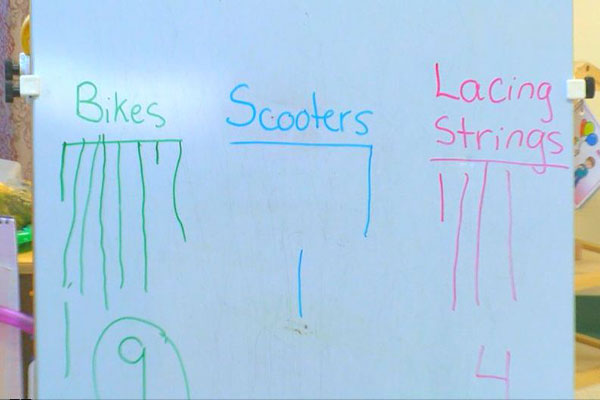Video Transcript for Data
Dr. Sudha Swaminathan, Eastern Connecticut State University: Data analysis and working with data offers children interesting opportunities to gather information to find an answer to a question. An important part is realizing that you have a purpose for collecting data. For instance, “What’s the favorite color in a class?” When teachers might invite children to come and look at the different colors and indicate their choice by picking a block that represents that color. They could then line up the blocks and count them out to determine which color is the most favorite.
Teacher: What’s your favorite? You like the pink as well?
Dr. Sudha Swaminathan: When we’re recording children’s data initially, we want to make sure we start with concrete objects, preferably, the actual objects to represent the data, and we can move on to pictures of the objects, and then gradually to more abstract symbols.
Teacher: We are going to vote on what materials we’re going to take out outside.
Dr. Sudha Swaminathan: The teacher might invite the children to indicate the choice by putting a tally.
Ashley Anderson, Preschool Teacher, Plainfield Head Start: Just the idea of their count carrying weight gets them excited about the materials. It gets them talking about it.
Dr. Sudha Swaminathan: So, there’s a purpose to that, and all data analysis stems from that purpose. You have to have a question. And then you try to gather information to find an answer to that question. And then the children count out the tallies.
Teacher: Which one has the most?
Child: That one!
Child: Green!
Teacher: What’s green?
Child: The bikes!
Teacher: The bikes.
Dr. Sudha Swaminathan: When children are analyzing their data, they’re going to naturally do another important math concept, which is comparison—comparison of groups. And so data analysis builds the bridge between these two important concepts.
How do you provide opportunities for Data Analysis? (2:17)
Narrator: Adults can provide daily opportunities for children to engage in this process.
Teacher: Your choices are either “Yes, the child did see a dog”, or “No the child did not see a dog.”
Supporting Math During Routines (2:36)
Narrator: A sign-in chart provides a meaningful display of data that can be observed and compared.
Teacher: Is there anybody still at home today? Child: (Shakes head.)
Teacher: No. How many friends are at school today?
Explicitly Teaching Math Concepts (2:53)
Narrator: Children can answer a daily question, to create a graph that can be discussed as a group.
Teacher: Which one is the triangle?
Integrating Math Learning in Play (3:07)
Narrator: Once children have experience comparing data, they can be supported to integrate this strategy on their own during play time.
Jennifer Wolff, Preschool Teacher, Cook Hill Integrated Preschool: My kids, they started doing their own surveys, and so they started going around the classroom with clipboards. They came up with their own questions, and so and then they had kids write their names, and they found out, you know, who likes dogs, who likes cats, and so they became interested in each other.
Teacher: All right, there’s another yes.
Child: That’s 10 yesses!
Teacher: Now there’s 10 yesses and there’s 4 nos. So how many do we have altogether?
Child: All right! Let’s count now!
Dr. Sudha Swaminathan: After children have collected data, teachers should, invite children to discuss, to observe, to describe what they see, and to engage in an analysis of their data.
© 2016 Connecticut Office of Early Childhood
Produced by the Center for Early Childhood Education at Eastern Connecticut State University.
May be reprinted for educational purposes.



